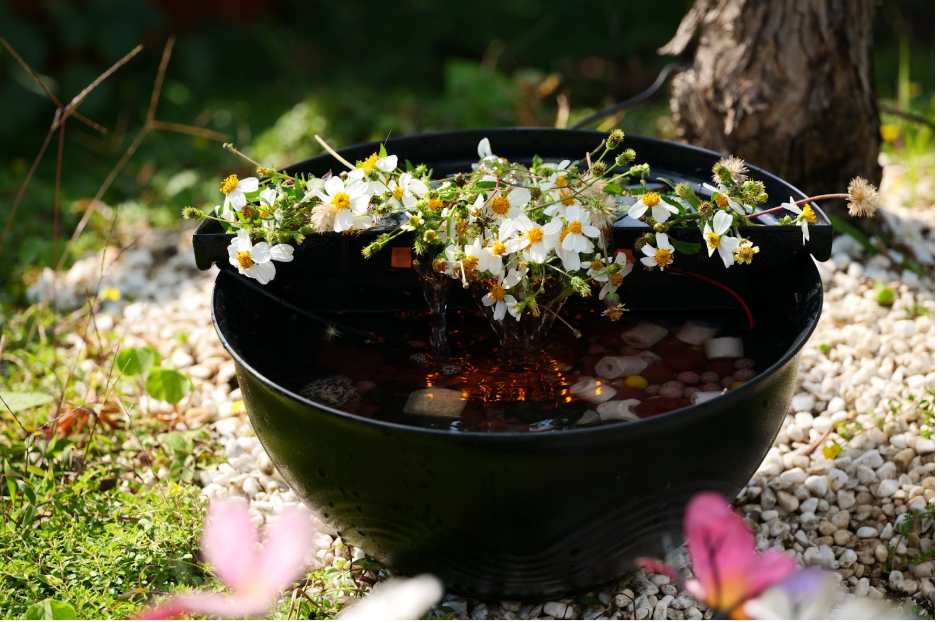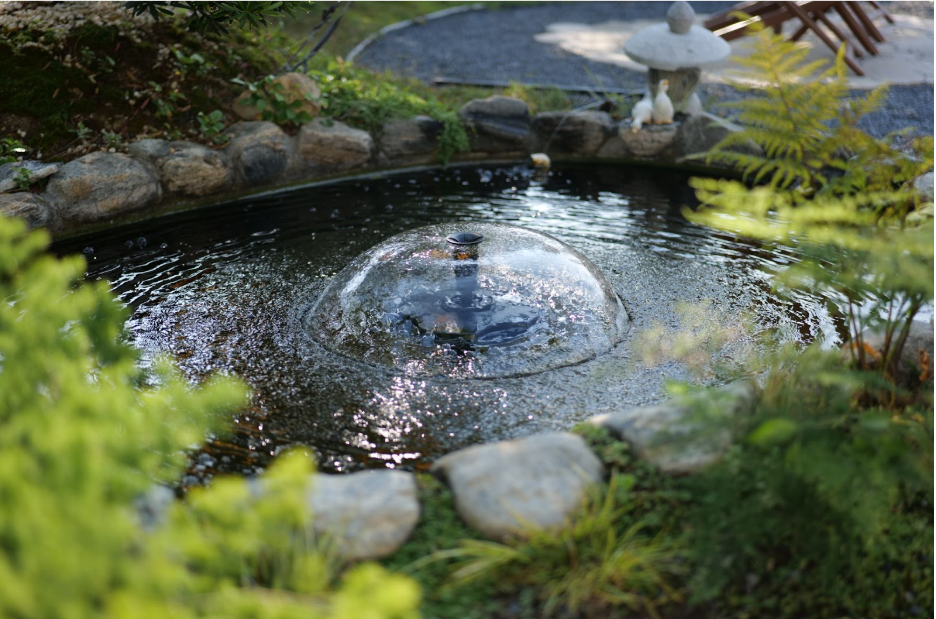What makes a garden truly unforgettable? Is it the flowers, the greenery, or the quiet corners? More often, it’s the sound of flowing water that lingers in memory.
Whether from the gentle stream of a fountain or the natural cascade of a pond waterfall, water transforms outdoor spaces into places of peace and beauty. Both options bring elegance and life to your garden, but knowing which one suits your space best can make all the difference.
Why Add a Water Feature to Your Garden
Water features have always held a timeless appeal in landscaping. They transform ordinary spaces into retreats filled with soothing sounds and captivating visuals.
Whether you choose a fountain or a pond waterfall, both options provide several benefits:
- Relaxation – Flowing water creates natural white noise that reduces stress.
- Attracting Wildlife – Birds, butterflies, and beneficial insects are naturally drawn to moving water.
- Enhancing Curb Appeal – Water features make gardens look more sophisticated and inviting.
- Cooling Effect – Water movement helps balance the temperature in outdoor living areas during warm months.
- Versatility – Fountains and waterfalls fit into gardens of various sizes, from compact yards to sprawling landscapes.
These benefits explain why homeowners increasingly consider water features when upgrading outdoor spaces.
Garden Fountains
Poposap solar water Fountains are versatile features that can be placed in courtyards, patios, gardens, or even indoors.
They typically consist of a basin that collects water and a pump that circulates it to create streams or sprays.
Advantages of Fountains
- Low Maintenance – Fountains are generally easier to clean and maintain compared to pond waterfalls.
- Variety of Designs – From classical tiered fountains to modern minimalist styles, fountains suit any landscape design.
- Compact Size – Perfect for small gardens or urban spaces with limited outdoor areas.
- Water Circulation – Helps prevent stagnant water and reduces the risk of mosquito breeding.
Limitations of Fountains
- Less Natural Appeal – While elegant, fountains may not mimic the appearance of a natural stream or pond.
- Scale Restrictions – Large landscapes may require bigger installations for fountains to make a visual impact.
Fountains shine in settings where simplicity, elegance, and practicality are top priorities.
Pond Waterfalls
Pond waterfalls are larger water features that integrate with a pond or artificial water body. They usually involve rocks, ledges, or slopes that allow water to cascade down naturally.
Advantages of Pond Waterfalls
- Natural Look – Perfect for those who want their gardens to resemble natural landscapes.
- Ecosystem Benefits – Waterfalls aerate ponds, supporting fish, plants, and aquatic life.
- Grandeur and Drama – Waterfalls create strong visual and auditory impact.
- Wildlife Attraction – Birds, frogs, and other creatures thrive in spaces with pond waterfalls.
Limitations of Pond Waterfalls
- Higher Maintenance – Cleaning ponds, removing debris, and balancing water chemistry require effort.
- Space Requirements – Waterfalls are not ideal for small gardens.
- Installation Costs – Building a pond waterfall often costs more than installing a simple fountain.
Pond waterfalls are best suited for those with larger gardens and a desire to create a vibrant ecosystem.
Comparing Fountains and Pond Waterfalls
When deciding between the two, consider the following aspects:
1. Space Availability
- Fountains fit into smaller yards and patios.
- Pond waterfalls require more room and look best in spacious gardens.
2. Maintenance Effort
- Fountains involve simple cleaning and pump maintenance.
- Waterfalls demand pond care, algae control, and debris removal.
3. Aesthetic Preference
- Fountains offer elegance and symmetry.
- Waterfalls provide a natural, rustic appearance.
4. Cost Considerations
- Fountains are usually more affordable to install.
- Pond waterfalls involve higher initial and ongoing costs.
5. Wildlife Impact
- Fountains attract birds but usually in smaller numbers.
- Waterfalls create full ecosystems supporting fish and diverse wildlife.
Both options add beauty and value, but the choice depends on whether you want a low maintenance ornamental feature or a naturalistic water ecosystem.
Choosing Based on Garden Style
Your garden’s overall theme plays a significant role in the decision.
- Formal Gardens – Structured fountains with tiered designs or contemporary fountains suit formal layouts.
- Natural Gardens – Rock formations and pond waterfalls blend seamlessly with wild or rustic landscapes.
- Small Courtyards – Compact fountains provide ambiance without overwhelming limited space.
- Large Yards – Multi level pond waterfalls create dramatic focal points.
Matching your water feature to the style of your garden ensures harmony and visual balance.
The Role of Pumps and Filtration
Whether you choose a fountain or a pond waterfall, pumps and filters are essential components. Pumps keep water circulating, preventing stagnation and ensuring the soothing sound of movement. Filters maintain clean water by removing debris and supporting aquatic health.
For example, a Poposoap pond filter can be an excellent addition to larger pond setups, keeping water clear and reducing maintenance needs. Pumps like the Poposoap solar powered water pump are eco friendly choices that reduce electricity costs and rely on renewable energy.
Sustainability in Water Features
Modern homeowners increasingly want eco conscious solutions. Solar powered pumps and fountains are excellent options that combine functionality with sustainability.
Instead of relying on traditional electricity, solar systems harness sunlight to power pumps, making water features more cost effective and environmentally friendly.
By choosing renewable energy based systems, you not only lower your energy bills but also contribute to reducing carbon emissions. Sustainable water features reflect a forward thinking approach to landscaping.
Incorporating Wildlife Friendly Features
If attracting birds and other creatures is one of your goals, you may consider incorporating designs that provide perching areas and shallow basins.
Features like the Poposoap solar bird bath fountain or the Poposoap solar powered bird bath are specifically designed to welcome feathered visitors while adding charm to your garden.
Birds enjoy splashing in shallow waters, and these specialized features make your garden a hub for local wildlife while keeping maintenance simple.
Practical Tips for Installation and Care
- Select the Right Location – Place your water feature where it receives sunlight for solar systems and where it can be viewed easily.
- Balance Sunlight and Shade – Too much sun encourages algae, while complete shade reduces solar efficiency.
- Maintain Pumps Regularly – Clean filters and pumps to prevent clogging.
- Monitor Water Levels – Evaporation may lower water levels, so refill as needed.
- Seasonal Care – In colder regions, consider winterizing your feature to protect pumps and basins.
Consistent care ensures your fountain or waterfall remains a stunning focal point all year.
Which is Right for You?
Ultimately, your decision comes down to balancing beauty, maintenance, and purpose. If you prefer simplicity, elegance, and convenience, a fountain may be the right choice.
If you love natural designs, biodiversity, and dramatic effects, a pond waterfall will better meet your needs.
Either way, integrating sustainable technology such as the water fountain offers an eco-friendly solution that enhances your garden while lowering energy costs.
Final Perspective
Fountains and pond waterfalls both provide unique benefits to gardens.
Fountains are ideal for those seeking simple elegance and lower maintenance, while waterfalls suit larger spaces that embrace natural aesthetics and wildlife.
By considering your garden’s size, style, and maintenance capacity, you can choose the water feature that perfectly aligns with your vision.








